The post The African Poet Patriot in Nsah Mala – Unpacking CONSTIMOCRAZY: Malafricanising Democracy appeared first on Global Arts and Politics Alliance.
]]>CONSTIMOCRAZY is a story of Africa weaved by an African poet patriot, a slinger wielding the spear, his pen, against treachery perpetrated by history and its cruelty. The same pen wielder rebukes Africa for frying its own beauty, dignity and morality in copper-roasting furnaces of disgrace and despotism. The African poet patriot traverses with us around, from African natural landscapes, up to the climes of the slave master where Africans are bleached in English syntax and spaghetti culture. The poet and his poetry are an experience of Africa, her story and his story. Though the poet seems intoxicated by pessimistic verbal concoction, the poet patriot does not completely relegate the reader to wallow in pastures ridden by slavery nagana, valleys smitten by colonial whooping cough and pathways strewn by African despotism. The poet is a natural wanderer, a traveller of course. Nsah Mala brings to the fore a dose of optimism as he drags us through mystic endowments of Africa and natural wonders of mother Earth, shifting our minds off from tragedies and economic ailments to the mysterious beauty the earth carries in its belly, especially if it was given more time to heal from scars poised by history and bruises of present-day scuffles. The African poet patriot is a master of word economics and a dexter in carving paradoxical verses.
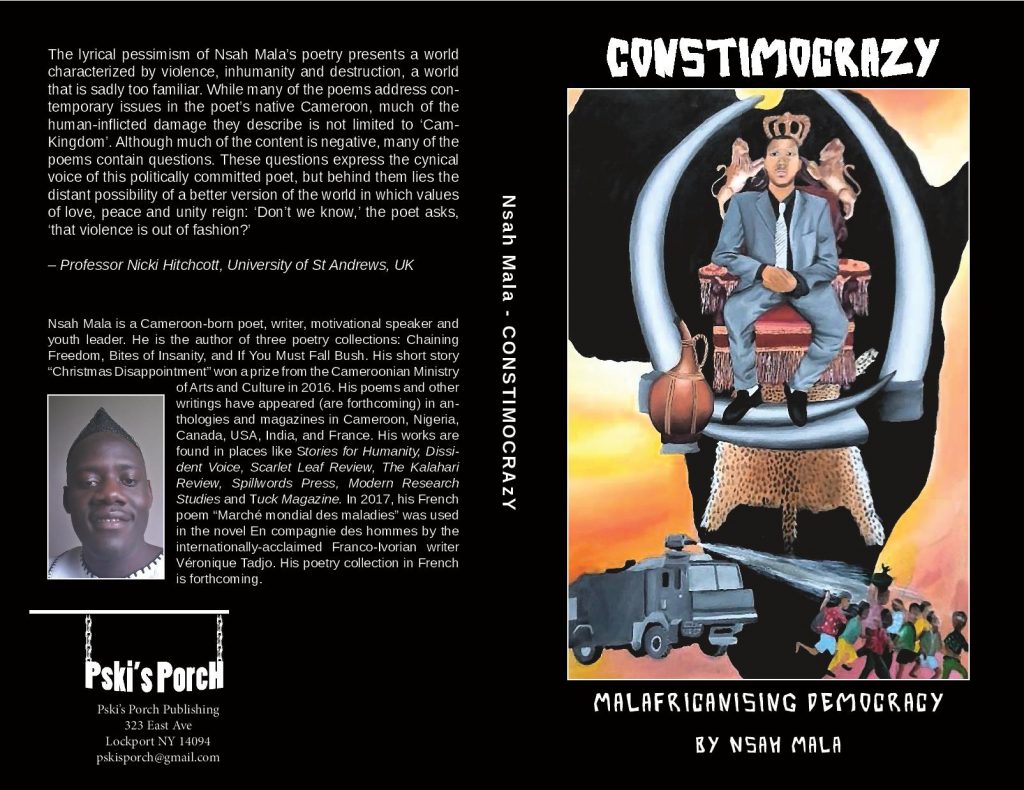
CONSTIMOCRAZY is divided into two parts. This graphical arrangement is supposedly intentional by the writer poet who wants us to follow through his story weaved in poetry like trackers in a journey alongside a great river. The collection is truly great river, whose waters flow both vile and pure: we meet whispering crocodiles, hissing snakes, beautiful fish, gurgling streams, singing birds, dancing mermaids and their rituals, fishermen and their lines, hippos and rotting carcasses, beautiful valleys, gowns of mist, stunning gorges and laughing waterfalls.
Mala interrogates the present day African with a poetic whip in his hand; his pen is his whip. The poem “Refugees” reflects the rot that stinks in the African rondavel: “Out of their abodes, something pulled them: natural – earthquake, flood, eruption, tsunami… man-made – strike, coup, war, terrorism… War and terror are the worst of them all.” The poem grapples with pain, displacement, identity crisis and lack of belongingness. And these are contemporary African crises, which have become generational, even after the calamities of slavery and colonialism. These tragic crises mainly come from within; they are perpetuated by warlords, poor governance, terrorism, banditry, despotism and corruption by the post-independent African leadership. In the same poem, the poet also points out how the angry finger of God contributes to nature-caused tragedies: earthquakes, floods, eruptions and tsunamis. These natural tragedies are not only threatening the African child but also go beyond African borders. However, in Africa they are extremely severe, as they are inherited again from generation to generation due to carelessness, poverty, poor resource management and lack of preparedness and then the refugee tragedy becomes an African totem problem. Mala also reminds Africa to get organized and walk in the path of light as her children suffer as underdogs in alien lands. Most of the poems in the first section exhibit political decadence, economic malaise and moral rot in Africa. In most cases, in the closing lines of his poems, Mala reminds the reader, the perpetrator and the victim that light can still show up if we remain resilient and correct our past hurdles; that we can also reshape our present.
In the poem “Forced into Oblivion”, Mala plays the role of a traditionalist, a griot, a ritualist. He pays tribute to a national fallen hero through a soul-nipping poetry rite. Thus, his role as an African griot, a beacon of religious light. The poem identifies Africa as a hub of religious diversity. Africa is a calabash frothing with super-concoctions of diverse beliefs, traditions and sacred rites we perform for the dead: praises, songs, poems, dances, the animal blood we spill for them and the millet brew we spit on their fresh graves in the spirit that they will rise again to live with us, protect us and be at peace with us. It is again our show of respect to the reputed departed who might be silenced by death but still linger among us. Here the poet becomes a traditional ambassador of his people; he becomes a cultural diplomat who serves the audience with a menu of sacred rituals of a departed family or national hero in his land:
… I trod across seas of dust
to pour on your tomb my buckets of tears
and clear away the labyrinth of aching fears
which have haunted me since you left in 1989
‘coz we did not unfeather fowls on your tomb!
We did not tear family sackcloth after your burial.
We did not tie the gods’ fowl above your corpse.
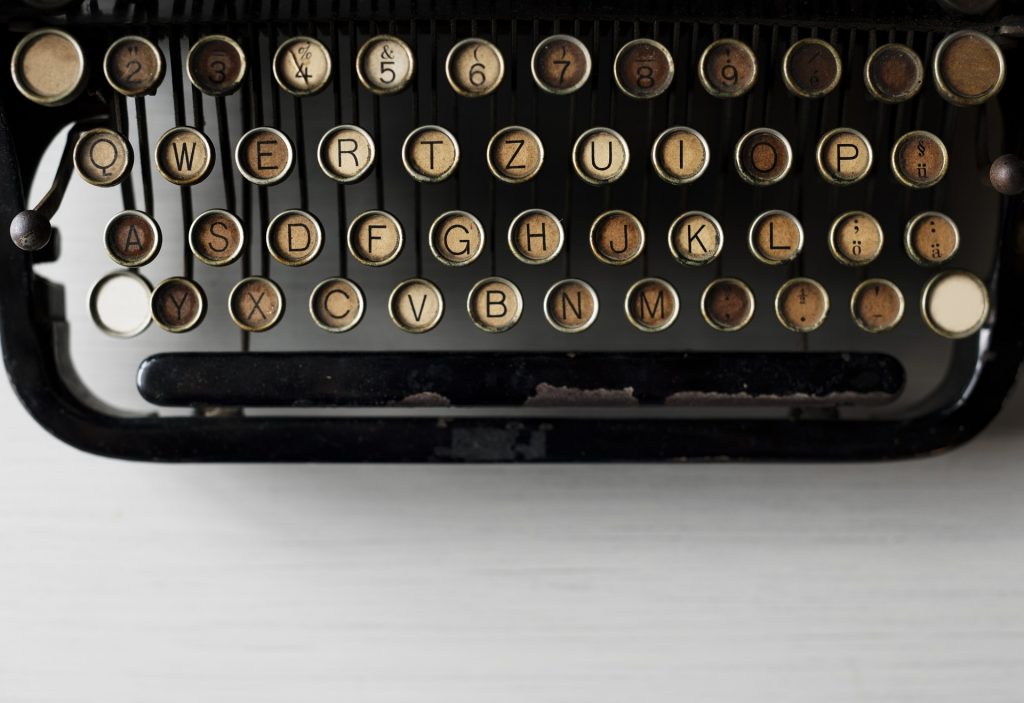
The African poet patriot in Mala also knocks heavily on the iron-buckled doors, whose tenants are dictators, despots and autocrats, through his poem “Sonnet for Dictators.” In this poem, the African poet patriot renews himself into the African word slinger. The poet is candid and brutally honest; his verses know no sacred cow. He reminds despots that they are a minority and they thrive on using the masses to gain popularity and benefit from power. Because of their negative energy extremes, they munch constitutions and they become constitutions themselves. They squash law under their feet and they become law themselves. The poem is rather ironical on its tail as the poet bemoans the absence of Gadhafi, assuming that he was a better dictator who led a rich country while other African leaders drink and suck everything out of their earth – the real dictators. The poet here plays teacher and counsellor. He is trying to rehabilitate rabid African leaders who have since become unrepentant and infected their countries with deadly autocratic rabies, not so easy to heal, and dictatorship has since become endemic in Africa: “After polls, all governments are a dictating minority,// but chosen by and answerable to an electoral majority.”
In conclusion, Africa is blessed to have birthed the calibre of such candid and brutal-honest word slingers and griots of our black continent like Nsah Mala. Africa will never be the same as the poet rebukes the bastardization of Africa by colonial trendsetters. The patriot poet voices against the tragedy of dictatorship, political and moral decadence. The poet Nsah Mala is a true African patriot, a story teller, a teacher, a cultural activist and an overseer of African dignity.
Mbizo Chirasha, is the Originator of the Zimbabwe We Want Poetry Campaign( www.tuckmagazine.com/mbizochirasha) ,the 100 Thousand Poets for Change-Zimbabwe Resident Coordinator. 2017 African Participant of the International Human Rights and Arts Festival , New York United States of America, a Global Political and Arts Alliance solidarity Member.Chirasha is a magazine editor ,blog journals publisher .He works as a Poet and Writer in Residence, Arts Projects Catalyst and Opinion maker, www.wikipedia/wiki.com/mbizochirasha
The post The African Poet Patriot in Nsah Mala – Unpacking CONSTIMOCRAZY: Malafricanising Democracy appeared first on Global Arts and Politics Alliance.
]]>The post GAPA meets… Mbizo Chirasha appeared first on Global Arts and Politics Alliance.
]]>Mbizo is an exiled Zimbabwéan performance poet, writer, publisher of blogs, project expert and social justice activist. He has been active in many organisations and has been published on more than 400 platforms. He has run and founded a number of initiatives including the Young Writers Caravan (2004-2006), This is Africa Poetry Night (2006), African Drums Poetry Festival (2007-2008), and the GirlChildCreativityProject (2011 to present), Mbizo is the current Resident Coordinator of the 100 Thousand Poets for Change- Global (USA) and the Women Scream International Poetry Festival (Domican Republic).
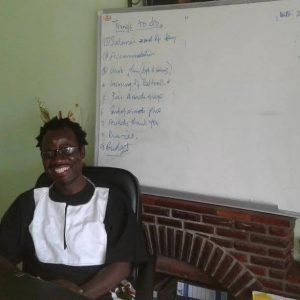
Can you tell us in a few words about the campaign you just launched? Is there a particular context that gave you the idea for it?
The Zimbabwe We Want Poetry Campaign is a strong intiative on CREATIVISM or Art Activism, which is a new global concept for using art and creativity as tools of resistance, positive transofmraiton and change. It is not a secret that Zimbabwe is under siege because of the dictatorship, corruption, hegemony and kleptomania . The ruling regime has failed the masses for 20 years and people generally need new leadership. The regime thrives on violence, and abuses of human rights, media rights, and economic rights. I believe it is the duty of any sane citizen, writer, poet, media corporate or activist to speak vehemently and without fear about these vices that continue to haunt my once beloved nation.
What led you to tackle themes of political violence in your work?
The notion of writing, speaking your experiences and what you know is a useful one. My first-hand experience is that I personally was politically violated for many years in my country, when we are forced to go to rallies every election season, our women sometimes are raped, young people beaten to death because they don’t support a certain party. The opposition political leader Morgan Tsvangirayi suffered several injuries through political violence. Tsvangirai, opposition politicians, resistance movement leaders, poets, writers, artists have suffered the brunt of political violence as perpetuated by the regime under this full-time dictator Robert Mugabe. I fled the country because I wanted to live and tell the world about my experiences that had become tough in 2016/17. I am still haunted. I know I have full information of what is happening. I was tailed most the evenings by details that proved to be of political alignment in nature. I was nearly abducted near Forth street sometime in January, I was nearly killed at a house I stayed at in Harare, I was nearly killed in another suburb while my friend was in another city. The Zimbabwean system does not want critics, they want praise singers. As we speak right now the regime has since launched a serious social media bombshell through the establishment of the Ministry of Cyber security, Threats Detection and Mitigation in a bid to silence voices and oppress citizen media – if that is not political violence then it is something else.
What relation do you see between politics and poetry? Do you feel a responsibility as a poet to speak out on political issues?
Yes, it has come a time in Zimbabwe when stagnation is not an option but a sign of failure, the fact that we are poets and that we need to be silent is a big mistake. We can’t rot while we watch, we need to call out for bandages and medicine, we need sanity in Zimbabwe. The old man is silencing our voices. Remember poets like Langston Hughes, who made great significance in the quest for change. They effected a perception shift in America through their black consciousness and renaissance writings. Renaissance is one greatest epochs of achievement in history of America that corrected the vices of slavery and racial perceptions. Creativism and Activism are very important concepts for positive transformation, change and resistance. We are adding up our voices against a totalitarian oligarch that is running the bureaucracy of the country in private restaurant meetings, bedrooms and kitchen cabinet gossips. An oligarch that is running the nation in a colonial model, an Oligarch that thrives on kleptomania, violence and looting. Our poetry shall speak and we will never stop, killing the flesh will never stop our voices. As long as dictatorship is present in Zimbabwe, creative resistance will remain.
In an article, you invited “young Zimbabwean artists to speak from wherever they are”. Do you see the Zimbabwean diaspora playing a big part in your project?
They are big players in this kind of campaign, they know everything about our homeland, they are happy with the news of gory events taking place every day, they send money to their kith and kin and that money rot in banks or disappear sometimes. They are many in the diaspora who want to be living in their home country, but the biggest challenge is the messy political economy of this country and other negative factors. These include overstayed leadership, victimisation and violence all these are syphilitic opportunistic infections of a totalitarian Napoleonic regime led by Robert Mugabe. The diasporas have Zimbabwe at heart, but they are failed by the home system -many of them are both political and economic refugees and they wish one of these days to be home again. We have a number of them contributing to our Brave Voices Poetry Journal, Word Guerillas Protest Poetry Journal, and Poets Free Zimbabwe.
What goal do you hope to achieve with your campaign?
This creativism concept seeks to bring sanity in Zimbabwe, politically, economically and socially. The campaign seeks to add voice for the redemption of the majority of suffering Zimbabweans. We need the respect of human rights, media rights, citizen rights and political rights. Zimbabweans need to have Freedom of Expression. We need a new administration that is dipped in democratic leadership ethics, in order for this authoritarian Hitler-Goebbels style of dictatorship dangling its grinding axe in villages and urban streets of Zimbabwe to be stopped.
Following the recent political developments in Zimbabwe, GAPA is proud to publish Mbizo’s poetry.
Madame (satire)
Madame, when the sunrays spark through the rim of hills flanked by our poverty, scratching villages of peasants,
Madame, Toyi-toyi to Nyazvidzi streams and vomit your disease, your anger, vomit your dread and hatred laced heart into the water that your anger helps the river to laugh and reeds to dance,
Madame , i see you smashing kindergartens with your corruption tired, sanctions smitten, ambition gloved hardy, gritty like sand palms,
Madame, i see your anger ridden slogan descending over the cascading, smoky presidium rondavel leaving others to lick burnt scars,
Madame, i see you wielding your slogan like hammer chiseling mercilessly the flesh of the state,
Madame, your mouth is a bitter pot where honey will not drip, your words stink war like in Baghdad,
Madame, your loose verbal saliva laced with acid burnt the hopes of the villagers,
Madame, we lost our country in your foul cracked lips and our dreams in alleys of your seething anger,
Madame, your dance is a magnet to paparazzi and your vitriol is fodder to pen wielders,
Madame, sit down next to the streams, vomit your ambitions and your disease – hatred,
Madame, children and daughters await a better and a new song from you, Sons are tired of baboons alike laughing at your rants and careless vengeful, fistful slogans,
Madame, when the sunrays spark through the rims of hills flanked by our poverty, scratching villages of peasants, trot to the river and vomit your anger, when at night shadows will be your company during the day crocodiles will be your sentry.
Dedication to the First Lady of Zimbabwe after the South African diplomatic gaffe in August 2017
The post GAPA meets… Mbizo Chirasha appeared first on Global Arts and Politics Alliance.
]]>The post Basquiat at the Barbican: the enduring magnetism of an art icon appeared first on Global Arts and Politics Alliance.
]]>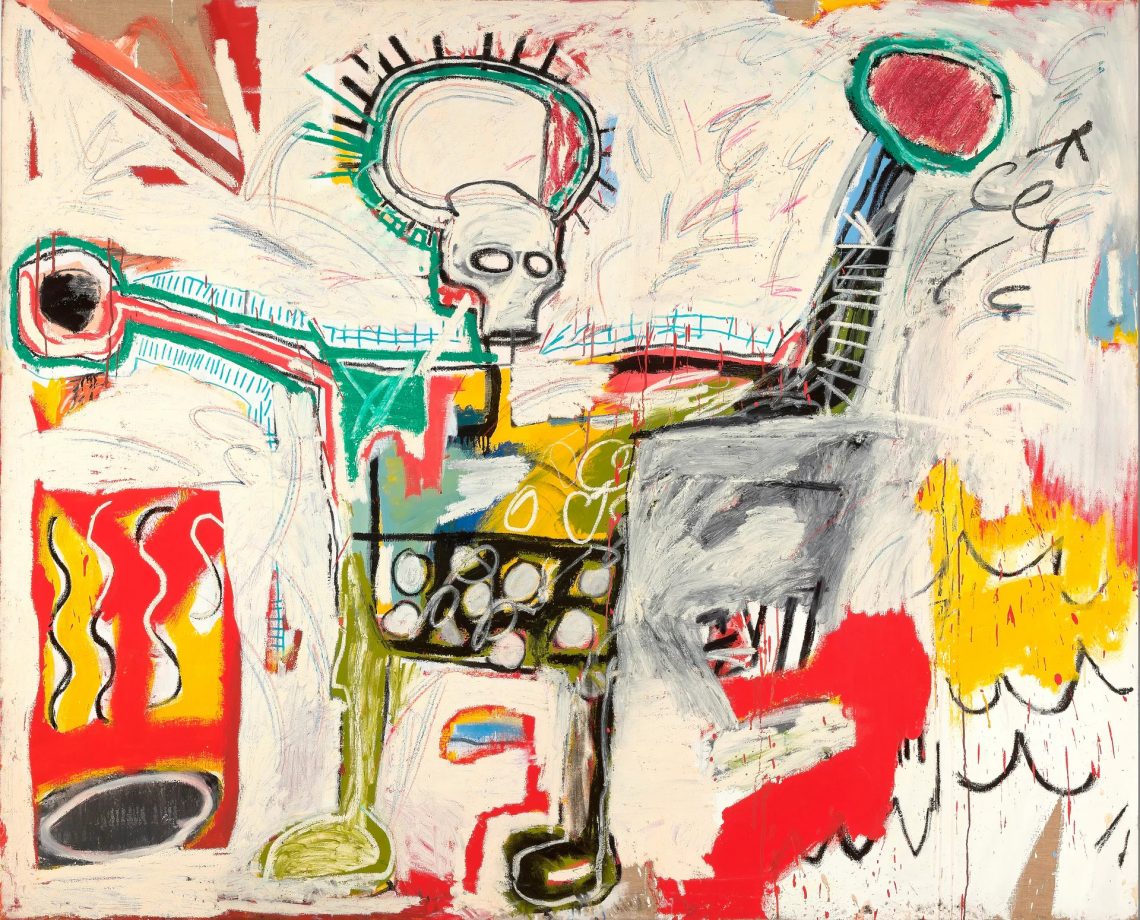
Jean-Michel Basquiat’s Untitled (1982). Photograph: Jean-Michel Basquiat/Barbican
One of the year’s most hyped exhibitions “Boom For Real”, a Jean-Michel Basquiat retrospective, has just opened at the Barbican. The show is the first of its kind in the UK, drawing huge crowds and plenty of chatter. Accompanying Banksy artworks appeared splashed on the walls of the brutalist monument days before opening night, only adding to the frisson of building as the show drew nearer. For an artist who has been gone longer than he was here, the appeal of Basquiat has proven enduring.
For an artist with such a relatively short career, perhaps this isn’t as surprising as it could at first seem. Jean-Michel Basquiat had all the makings of a tragic cultural icon – raw talent, sudden fame, and a tragic death. Leaving us at 27, Basquiat is an artist who only really had the chance to start his career, and tragically romantic stories of this kind have always held a place in the public’s heart.
Aside from his distinctive work, the charisma of Basquiat himself is much in part what catapulted him into the spotlight in 1970s New York – a wild and unforgiving urban sprawl suffering from years of financial neglect and impoverishment. This context projected Basquiat as perhaps the perfect mascot for this period of gritty, DIY, raw creativity that dominated the New Wave movement.
Posthumously, his allure remains, and this has in many ways informed the nature of the show. This is not simply rooms that chronicle the periods of an artist’s career, as a retrospective often can be. Instead, each room serves as an homage to the many different aspects of Basquiat’s diaspora of creative outlets. Painter, writer, celebrity, music lover and producer – each room is an angle of insight into each of the foundations that made up this icon as a whole. Rooms of beat-bop, catalogues, zines, recordings, photography and books deconstruct his influences and inspirations, contextualising his life to the degree that by the time that you leave, you feel personally acquainted.
Significantly, many of the pop-cultural movements that Basquiat was associated with are still hugely relevant parts of contemporary conversation. Street art, black history and civil rights in the US, and the advent of Hip Hop in pop culture are just a few elements that leave the viewer with a feeling that Basquiat was very much a part of our culture today. His work, interests and influences don’t feel dated; in fact if you squint, it could be believed he were a contemporary practising artist.
This may be the key to the enduring magnetism of Jean-Michel Basquiat – although very much a figure associated with Debbie Harry, Warhol and 1970s New York – he is also somehow just as effortlessly cool, openly creative, in vogue and ahead of his time as he was 30 years ago.
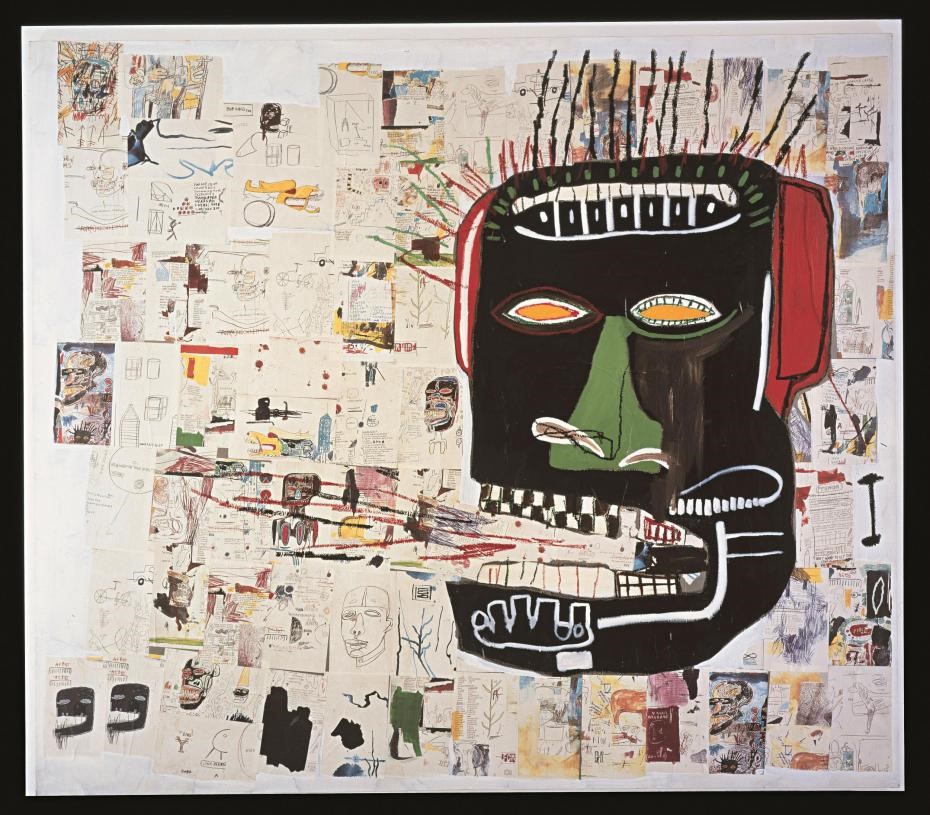
Jean-Michel Basquiat’s ‘Glenn’, 1984 The Estate of Jean-Michel Basquiat. Licensed by Artestar, New York
‘Boom For Real” is now open at the Barbican Centre until the 28th January 2018.
For more information go to https://www.barbican.org.uk/whats-on/2017/event/basquiat-boom-for-real
The post Basquiat at the Barbican: the enduring magnetism of an art icon appeared first on Global Arts and Politics Alliance.
]]>The post Queercircle: the group of LGBTQIA+ young Londoners promoting inclusivity in queer contemporary arts. appeared first on Global Arts and Politics Alliance.
]]>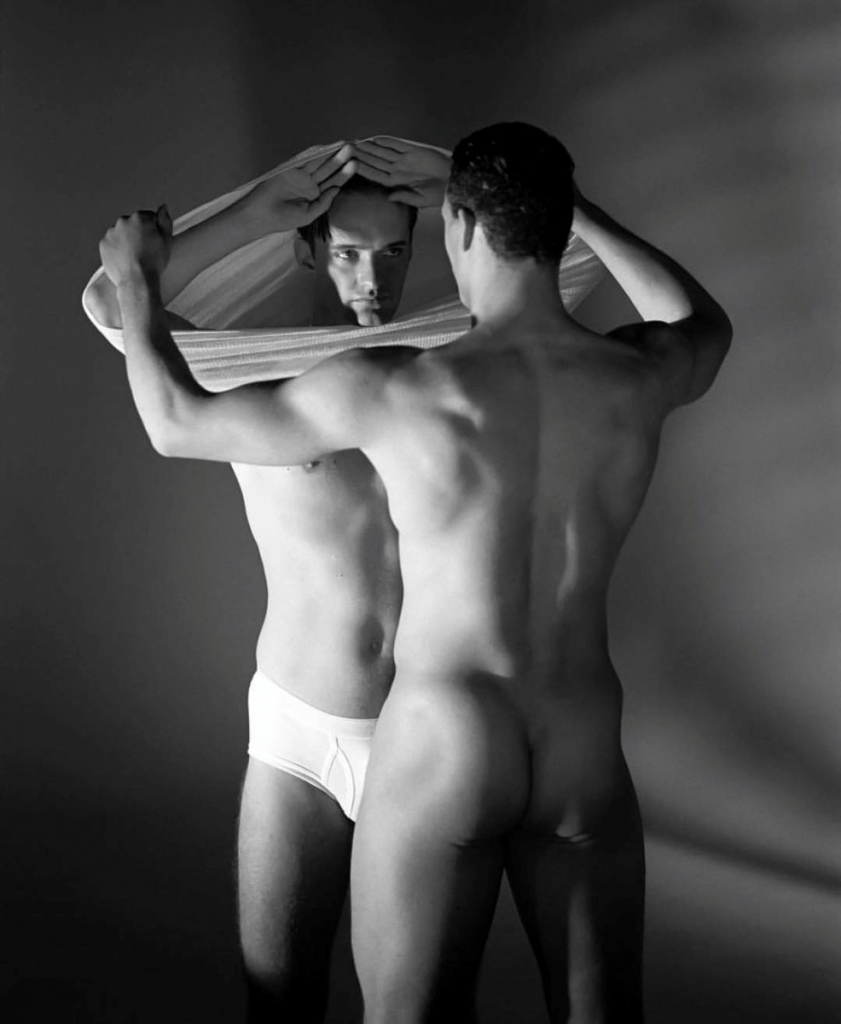
Photograph from exhibition ‘Looking for Langston’ by Isaac Julien at The Vinyl Factory July 2017.
Queercircle
The group of LGBTQIA+ young Londoners promoting inclusivity in queer contemporary arts.
There’s a grass roots, raw energy to Queercircle events. It’s a no-money, all-energy enterprise of a group of young passionate devotees committed to promoting an inclusive queer arts scene in London. Their platform is to help “… support and celebrate all forms of Queer expression, engage in conversation and build a collaborative, creative community.” Despite having only launched last year, from exhibition openings to queer cabaret, Queercircle confidently blends the old and the new, and mixes it all up together.
And this is exactly what makes groups like Queercircle different to the culture of queer events that have preceded it – spaces which were once the sole haven for a sub culture of a persecuted social minority. This was a time when being gay was illegal, and marriage equality was a pipe-dream. These were important, valuable spaces for queer people to convene and support each other, but they came along with the unfortunate side effect of exclusivity. This was the one safe space away from a tough and dangerous world. Straight people were not welcome to these spaces that were, and are still, so vital to the queer community.
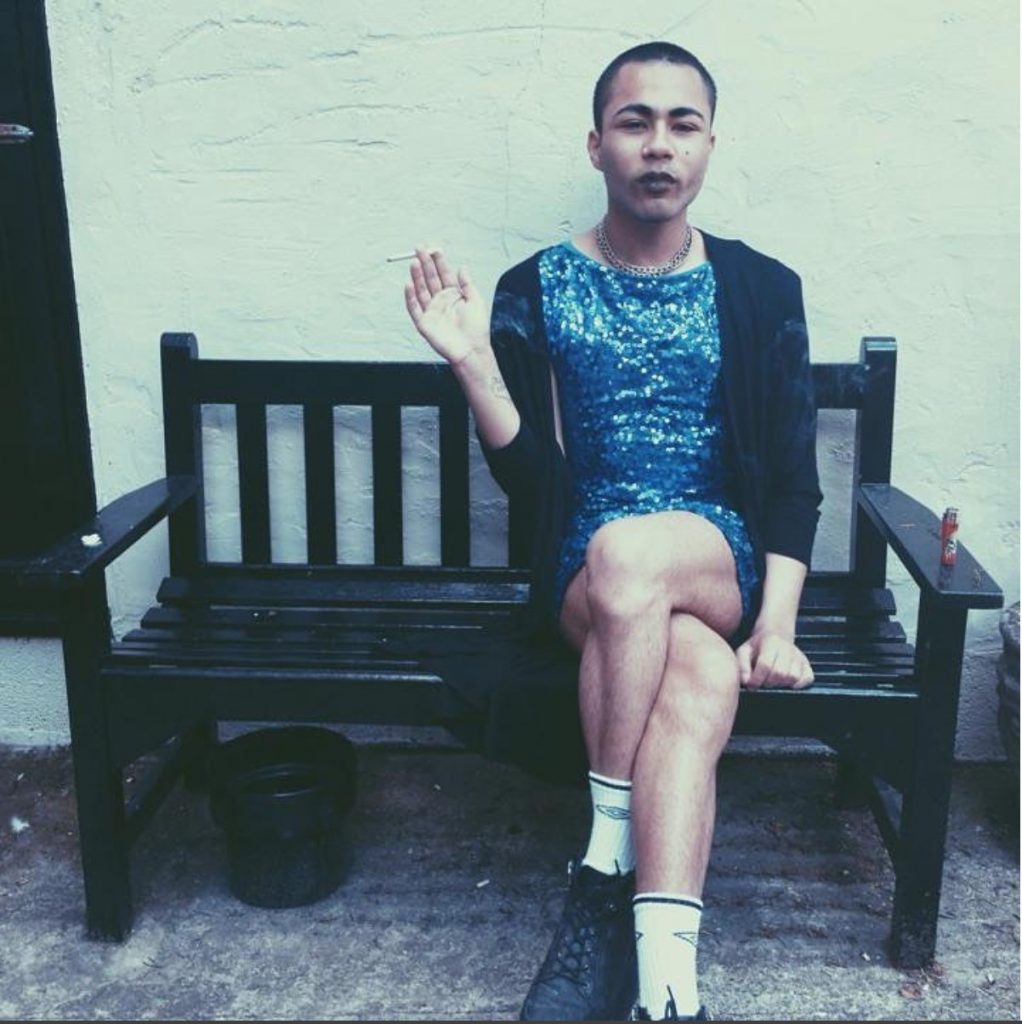
Artist Travis Albanza, a non-gender conforming performance poet who performed at the Queercircle Launch in Oct 2016.
Now it’s 2017. A larger attitude shift towards the way gay people are treated within society has been a slow and growing wave. Year after year, gay marriage has become legal in more and more countries around the world, with England and Wales joining the list in 2014. Now, these events are about bringing people together and celebrating their humanity in all their weird and wonderful varieties of queerness.
The name itself, the reclamation of the word ‘queer’ – formerly a derogatory term – is representative of a young and growing generation who expect and encourage inclusivity in the community. This is a time where gender binary is seen as old-fashioned, and you no longer have to be just ‘straight’ or ‘gay’. A big, beautiful spectrum of identifiers is available to us all, and this kind of attitudinal change is reflected by more general terms such as ‘queer’, which allow more nuanced senses of identity to play with everyone else. Nowadays, we’re all invited to the party.
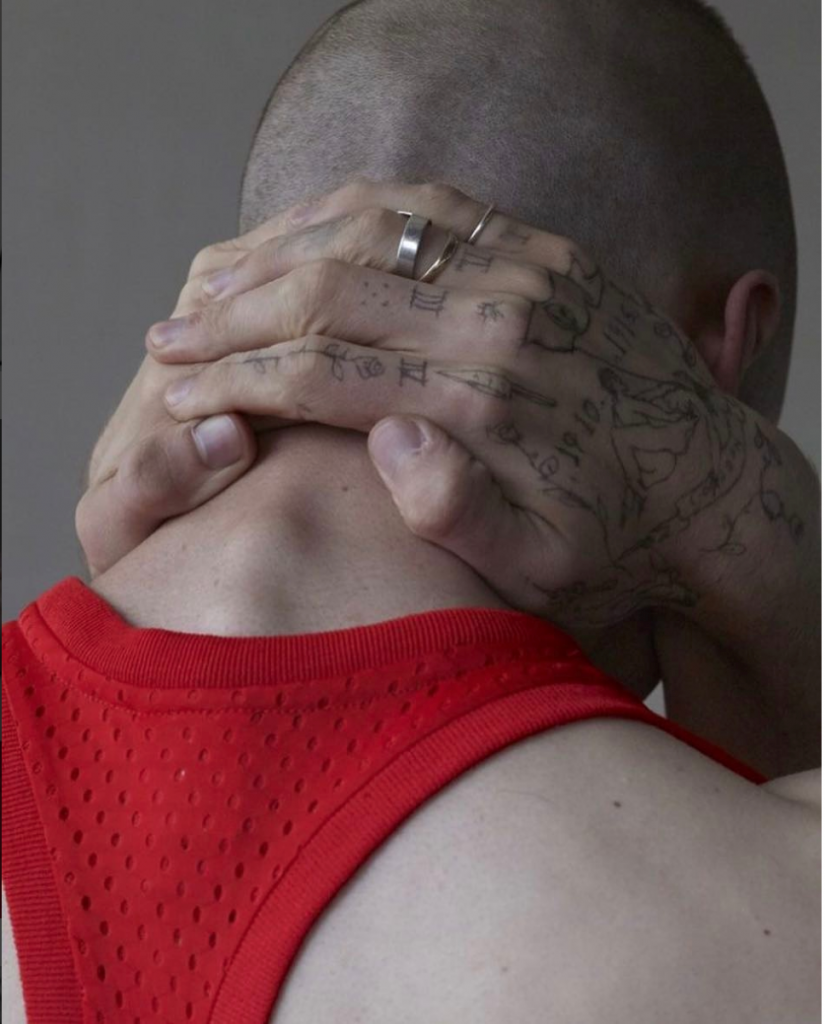
Collaboration between Dominic Hyatt and Mert Alas for Love Magazine 2016.
Not only in London but in many cities all over the world, this kind of queer celebration of love, to which everyone is welcome, has increasingly become the standard. A general sense of inevitability prevails amongst younger generations, tinged perhaps with a frustration that equal rights aren’t yet universal but obviously will be. The hardships of the past that have caused rifts between different sub-sects of the gay community, such as the prejudice of the greater gay community against the legitimacy of the bisexual community for example, now seem to be a distant memory.
We are all involved, we are all connected and Queercircle wants to provide a space to appreciate the artists amongst us, who are using their work to help break down the barriers that once kept us apart, and most importantly celebrate our differences – together.
You can find more information about Queercircle on Facebook, Twitter and Instagram.
The post Queercircle: the group of LGBTQIA+ young Londoners promoting inclusivity in queer contemporary arts. appeared first on Global Arts and Politics Alliance.
]]>The post Audio we love: podcast recommendations of the month appeared first on Global Arts and Politics Alliance.
]]>
Under the Skin – Interview with Yanis Varoufakis
Comedian and vocal social critic Russell Brand interviews former Greek Minister of Finance Yanis Varoufakis in his podcast Under the Skin. Varoufakis and Brand bounce ideas off each other about transcendence, alienation, and spirituality, finding merit in human connection, empathy and faith. Varoufakis makes a strong case for constructive disobedience and gives advice on what can be done tomorrow morning to achieve a more just and sustainable world. Listen to the whole episode here.

BBC Radio 4, Reith Lectures – The Day is for the Living
Art can bring the dead back to life, argues the best-selling novelist Hilary Mantel, starting with the story of her own great-grandmother. “We sense the dead have a vital force still,” she says. “They have something to tell us, something we need to understand. Using fiction and drama, we try to gain that understanding.” Dame Hilary discusses the role that history plays in our culture. How can we understand the past, she asks, and how can we convey its nature today? Above all, she believes, we must all try to respect the past amid all its strangeness and complexity.

BBC World Service, World Hacks – Mexico’s Cartoon Therapists
How do you get children who’re victims of emotional abuse or physical harm to open up about what’s happened to them? In Mexico a psychologist, Julia Borbolla, encourages them to have a one-to-one chat with a cartoon alien that appears on a video screen in a room near her office. What the children don’t realise is Julia hears every word of their conversation with the animated creature because she’s secretly controlling it from the room next door. She says children are more likely to reveal sensitive information to the cartoon alien than if they were face-to-face with a real person.
The post Audio we love: podcast recommendations of the month appeared first on Global Arts and Politics Alliance.
]]>The post Hip-Hop Feminism rising in Latin America appeared first on Global Arts and Politics Alliance.
]]>By Kirsty Flockhart
“Tengo millones de huevos en cada ovario / No me hace más mujer ni a vos te hace menos macho”
(I’ve got millions of eggs in each ovary / it doesn’t make me more of a woman or you less of a man)[2]
- Bandera Negra (Black Banner) by Rebeca Lane, Guatemala.
Feminist Hip-Hop is a music movement that appropriates the style and aesthetic of popular American Hip-Hop to advocate women’s rights and gender equality. Young artists from various countries across Latin America are using Hip-Hop rapping to critique manliness, misogyny, and evaluate the general understandings of gender within Latino cultures. Hip-Hop Feminism tends to relate more closely to third-wave feminism, in which notions of ‘universal womanhood’ are critiqued and it’s participants dealt more specifically with race and class. Participants in the movement seek to criticise the media’s mainstream representation of Hip-Hop and provide alternative music that promotes egalitarianism in race, gender, class, sexuality, and identity.
Hip-hop culture originates from The Bronx, New York City from the 1970s. Initially started by Disc-Jockeys (DJ’s) and self-titled ‘Masters of Ceremonies’ (MC’s) who began using turntables to create mixes of various songs for young people to dance to. One of the foremost figures of American Hip-hop was Kool Herc, who advocated his dance parties as a means of deterrent from gang fighting in the local neighbourhoods. The idea was that the community would get together and burn off energy dancing rather than fighting. The scene includes MC’s, Rapping, Breakdancing and Graffiti. The culture of Hip-hop developed out of minority groups and communities that had been excluded from mainstream society. For example, the way that The Bronx was left mostly derelict during the late 1970s. The people living there were forced to forge their own culture as a reaction to living on the peripheral of American life. The Bronx during the 1960s was known for extreme fires and dilapidated neighbourhoods, the conditions were compared with living in a war zone.[3] The people living in the Bronx felt dislocated from the rest of New York City. Hip Hop emerged as a successful subculture which allowed individuals to voice their concerns and highlight discrimination.
Latin American Hip-hop spread from North America to central, south and the Caribbean. Where large concentrations of immigrant areas in the United States tended to bring back the music style with them when visiting family and friends from their original countries. For example, the music was transferred from Miami, USA to the Caribbean island nations through radio transmissions and records being imported by family members and friends. Latin American Hip hop uses Spanish language lyrics and varies with the sound styles. Generally it includes the customary sounds of hip-hop (the backtracks and repetitive beats) with Spanish language and slang. Some artists feature Latino dance rhythms such as Cumbia or Salsa music rhythms combined with the more traditional back beats.
Latin America tends to be associated with heavy sexism, ownership and violence against women. As a response to this, there is a growing subculture within Latin American hip-hop of women who are using the music as a platform to critique the music industry as well as their own cultures. Artists began using the music style to spotlight social issues for women’s rights. One of mainstream concerns of Hip-hop is its association with extreme masculinity, advocating of dangerous life-styles as successful characteristics. Hip-Hop feminists are appropriating the music style to reconstruct these beliefs.
Hip Hop’s Inheritance: From the Harlem Renaissance to the Hip Hop Feminist Movement Reiland Rabaka describes the scope of Hip-hop Feminism:
“Hip-hop feminism is much more than feminism, and it focuses on more than feminist issues, misogyny, and patriarchy. Hip hop feminists use hip hop culture as one of their primary points of departure to highlight serious social issues and the need for political activism aimed at racism, sexism, capitalism, and heterosexism as overlapping and interlocking systems of oppression […] hip hop feminists are simultaneously expanding the range and uses of intersectional theory and complicating what it means to be both a hip hopper and a feminist“.[4]
It is possible that Latin America’s history of Dominant Military leaders amplified the patriarchal-culture. Hip Hop stars from the late 1990’s United States tended to glorify homophobia and hyper-masculinity that echoes the machismo culture across Latin American countries. Hip-hop’s successful celebrity status combined with anti-authority gangsta-affiliation in the United States is part of its attraction to underdog groups. **
Much of the controversial hip-hop stars within the United States use their lyrics to degrade women and often feature in their video clips the ‘Hip Hop Honey/Video Girl’. These women are a variation of the ‘Ride-or-die Chick’ willing to support her man and his illicit lifestyle despite how this might endanger or harm her. Also known as ‘video vixens’, these women are often aspiring actors, singers, dancers, or models who appear in men’s hip hop music videos.
Rebeca Lane explains:
“…also at the level of the content, that the music you make be heterosexual in the sense that it showcases this topic of a woman loves a man, she dies for him, etcetera. And that you don’t inconvenience, that you don’t question, don’t talk about problems but instead keep talking about love from a heterosexual perspective and other topics that don’t make people uncomfortable.”

Somos Mujeres Somos Hip-Hop
There are several female artists and groups who are using the music to advocate women’s rights and combat the masculine narrative that hip-hop is for men.
An example of such a group are “Somos Mujeres; Somos Hip-Hop” (“We Are Women; We Are Hip-Hop”) which currently includes 12 women from 10 different countries across Latin America. MC Audry Funk from Mexico, met Roja (from hip-hip duo Rima Roja en Venus) from Ecuador whilst performing in New York City. In 2013 Roja organised the first festival ‘Somos Mujeres; Somos Hip-Hop’ in Quito, Ecuador. As various other artists have joined, including Rebeca Lane, Guatemala, it has continued to expand into female hip-hop collective. In 2015 the group recorded 12 tracks in an album titled ‘Latinamérica Unida’ on SoundCloud.

Audry Funk, Mexico
The compilation’s 12 tracks pulse with attitude and skill, in styles ranging from the melodic beauty of Chile’s Dania Neko to the harsh, guttural flow of the Colombian MC Jana. “Kutipakuy”, a song by Peru’s Sipas Crew, a trio of MCs from Portada de Manchay I, Lima, is one of the most arresting tracks, with Quechua words peppering lyrics underpinned by a hypnotic charango beat. [5]

Rima Roja en Venus, Ecuador
Rebeca Lane talks about her use of music as protest, to highlight the gender inequality and violence against women in her country, as well as Latin America.
So one always feels unsafe, either because you’re a woman, or you’re an activist, or simply being a young person. Having tattoos, looking different, in Central American territory, it’s a threat because you’re affecting the internal (order) and what should be, which is what militarism wants to impose on us–a single way of thinking, and this single way of thinking has to do with very traditional roles, both political and gender roles.[6]
The groups intend to use their music to raise awareness of the social issues across Latin America, combat sexism in the industry and act as role models to young women internationally. The lack of space for women in the industry has made the women participating organise themselves, form alliances and create their own events. Hip-Hop traditionally served as a space for the marginalised to voice their concerns and contest the popular narratives.
[1] https://i.guim.co.uk/img/static/sys-images/Guardian/Pix/pictures/2015/8/5/1438781213816/a853fc1b-bd7e-4904-8925-dc5c46133cdd1360x2040.jpeg?w=300&q=85&auto=format&sharp=10&s=b99cb54297c4e0c1711613960cf16883
[2] Rap battles across Latin America tend to refer to the size of men’s testes as “Huevos” in Spanish (meaning ‘Eggs’).
[3] Refered to by Grandmaster Caz as Like growing up in Beirut (…civil war)– Hip Hop Evolution Documentary and also from news reports about the time.
[4] Hip Hop’s Inheritance: From the Harlem Renaissance to the Hip Hop Feminist Movement Reiland Rabaka
[5] https://www.theguardian.com/music/2015/aug/09/how-latin-american-women-are-changing-hip-hip
[6] http://www.telesurtv.net/english/opinion/Guatemalan-Feminist-Rapper-Tearing-Down-Walls-20160312-0043.html
Kirsty Flockhart is Head of International Cooperation at GAPA.
The post Hip-Hop Feminism rising in Latin America appeared first on Global Arts and Politics Alliance.
]]>The post A note on “weltschmerz” and staying optimistic in a painful world appeared first on Global Arts and Politics Alliance.
]]>First things first: this is a very personal post and therefore isn’t scientific at all (as I am not a scientist myself). But what could be more political and artistic than to express yourself?
I want to introduce English speakers to a German term: weltschmerz. It literally translates to “world-pain” and expresses the feeling of sadness and melancholy for all the evil and bad in the world. And without wanting to be all pretentious I must say that this feeling accompanies me in my life. I read about the slow (but hastening) dying of our environment, slavery, poverty, terrorism and war. And I experience social pressure, homophobia, sexism (towards all the women I care so much for, but also against my own femininity) and emotional apathy in my personal life. And maybe you can relate to this, dear reader. If so, I know this can be a heavy burden and some people will mock you for your “naive” craving for a better world with less suffering. And you might be willing to accept the cynicism and surrender to the weltschmerz and just stop caring.
But sometimes, if you pay attention, you can see (and more importantly, feel) that there is more than “schmerz” in our world. There are people that dedicate their whole lives to the protection of our environment; there are organisations fighting against the violation of human rights; June is pride month and all over the world the LGBTQ+ community and allies are fighting for rights and owning and celebrating their own lives and achievements. There are passionate people fighting for women’s-rights and femininity all over the world. And most importantly, there are so many kind and caring people all over the world, true humanitarians that oppose the cynicism.
You might ask yourself why I am writing this. Well, today was a very painful day (on a personal level) for me, and I could feel myself getting cynical and hateful, but then I met a friend. We talked about all the pain in the world, but more importantly, we talked about love and caring about others. She helped me to stay true to myself, to preserve my humanism – and my humanity. And maybe I can share some of this with you, because despite all the weltschmerz, we are so many! There is hope! There is a reason to be optimistic! And together we can fight pain and misery in this world.
Florian Pock has been GAPA’s Treasurer since its founding in 2015. He currently lives in Graz, Austria.
The post A note on “weltschmerz” and staying optimistic in a painful world appeared first on Global Arts and Politics Alliance.
]]>The post Audio we love: podcast recommendations of the month appeared first on Global Arts and Politics Alliance.
]]>
The Scene – How Artists Can Be Activists
How can artists be activists? This is a question we’re very familiar with at GAPA, and we were really happy to see this addressed in a podcast by the Clyde Fitch Report. Although the podcast originally aired in 2016, it still offers valuable commentary on how artists can not only foster conversation, but also work directly with their lawmakers and communities to enact real change.

The London Review of Books Podcast – Diary: Burning Man
The now-infamous Burning Man Festival (read a review from last year’s event by former GAPA Board member, Kelly), which takes place each year in the Nevada desert, has attracted criticism in recent years.
Prodding at the shallowness and hypocrisy of the Burning Man experience now, Emily Witt looks at the way that “burners” – many of whom are wealthy employees of the tech industry – don’t retain the “revolutionary ideas” that are supposed to define Burning Man (isolation from the internet, radical self-reliance, and using illegal drugs) when they return to their ordinary lives. “The $400 ticket price was as much about the right to leave what happened at the festival behind as it was to enter in the first place,” Emily notes poignantly.

In this recent episode, felons – most who have committed murder, acts of paedophilia, rape, and other very serious crimes – perform Shakespeare’s Hamlet in a Missouri prison as part of a performing arts programme for prisoners.
“I’ve seen Hamlet a dozen times,” says Jack Hitt, who followed the story for This American Life. “But the truth is, this production was different, because this is a play about a man pondering a violent crime and its consequences – performed by violent criminals living out those consequences.” It’s a moving episode that brings up big questions about the enduring adaptability of Shakespeare’s oeuvre, the US prison system, and what rehabilitation truly means.
The post Audio we love: podcast recommendations of the month appeared first on Global Arts and Politics Alliance.
]]>The post In the Name of Art and Politics: What I Learned from Publishing an Art Catalogue on Lebanese aboard the Titanic appeared first on Global Arts and Politics Alliance.
]]>This May, 2017, I, along with co-editors Dr. Guita Hourani and Mr. Mario Najm, published the first ever art catalogue on the Lebanese aboard the Titanic. The catalogue featured a brief look into the politics and history of Lebanese migration, the history and context of the ship itself, as well as testimonies from relatives of those who perished on the great ship. The catalogue then went on to feature a 26-piece art exhibit honouring the Lebanese aboard the great ship.
How this Came About
The Lebanese Emigration Research Center (LERC) at the Faculty of Law and Political Science (FLPS), Notre Dame University-Louaize (NDU), the World Lebanese Cultural Union (WLCU) of British Columbia Council, and the Irish-Lebanese Cultural Foundation (ILCF) formed the “International Lebanese Titanic Committee (ILTC)” in 2012, the year marking the centennial of the Titanic’s tragic sinking. The committee was established to identify, commemorate, and pay tribute to the Lebanese aboard the Titanic, as well as work on revealing their names and stories.
Art resonated. It just does
The current ILTC committee members, as of 2016, are the following: Dr. Nick Kahwaji, DDS representing the WLCU BC Council; Guy Younes, Chairman of ILCF, Ireland; Dr. Guita Hourani, Director of LERC, Lebanon; Carla Zarifeh, representing the Lebanese Canadian Society of British Columbia (LCSBC), Canada; Dr. Josyann Abisaab, M.D., USA; Raed Charafeddine, first Vice-Governor of the Banque du Liban (BDL), Lebanon; and Sid Chedrawi, Founder Lebanese-Canadian Chamber of Commerce, Nova Scotia, Canada.
With the spirit of enriching the previously established collection on the Lebanese aboard the Titanic at the Lebanon and Migration Museum (LMM) at the LERC, NDU, in Lebanon, the committee collaborated with Vestiges D’Orient and the LERC in its call for paintings dedicated to the memory of the Lebanese who perished aboard the Titanic. The call encouraged artists to “[…] participate in the artistic expression on Lebanese emigration and the tragic Titanic incident.”

Artist Bernard Renno, owner of Vestiges D’Orient, led the call and was able to engage 26 artists from Lebanon to participate. The paintings were exhibited during the Lebanese Diaspora Energy Conference (LDE) organised by the Ministry of Foreign Affairs and Emigrants on 5 and 6 May, 2016, at the Hilton Grand Habtour Hotel in Beirut. Following this exhibition, the artists donated the paintings to the LMM at NDU, except for one which was selected by H.E. Minister Gebran Bassil to be exhibited at the Emigrant Museum in Batroun. The painters and organisers were honoured by the minister at the closing of the LDE.
What Went Down
The Lebanese Emigration Research Center (LERC) at the Faculty of Law and Political Science (FLPS), Notre Dame University-Louaize (NDU), in collaboration with the International Lebanese Titanic Committee (ILTC), Vestiges d’Orient, the World Lebanese Cultural Union-British Columbia (WLCU-BC), and the Irish-Lebanese Cultural Association (ILCA), organised the launch of the catalogue as well as the inauguration of the 27 newly-bequeathed pieces of art on the Lebanese Aboard the Titanic into the Lebanon and Migration Museum (LMM) at NDU on 2 May, 2017.
The committee was established to identify, commemorate, and pay tribute to the Lebanese aboard the Titanic
This collection, which is dedicated to the memory of the Lebanese who perished aboard — or survived — the Titanic’s ill-fated voyage, was unveiled at the Ramez G. Chagoury Faculty of Architecture, Art and Design (FAAD) exhibit hall in the presence of the artists, guests, and representatives of the participating organisations.
Two families, Abi Saab from Thoum and Azzam from Kfar-Katra, whose ancestors were among those who died 105 years ago when the ship sank, gave touching testimonies. Vice-Governor at Banque du Liban (BDL), Mr. Raed Charafeddine, delivered an exceptional presentation. He recounted his observations during a voyage he took during the official centennial celebration, which retraced the Titanic’s route. Charafeddine discussed the lessons he learned during the journey particularly regarding leadership lessons from this historical incident.
What We All Learned from This
Art contributes to politics in every area, whether in critical thinking, aesthetic, directing societies, providing peace and order or mostly, in providing an outlet
Fruitful discussions among artists, activists, historians and art critics at the event shed light upon the fact that art contributes to politics in every area, whether in critical thinking, aesthetic, directing societies, providing peace and order or mostly, in providing an outlet – a matter more than one artist stressed in their conversations with me.
Artists have affected societies for centuries without the need to directly express a blunt political statement, but rather through preserving their artistic identity as this blunt statement. Art has been central in informing society about communal, political, social, cultural and economic realities without the texts, without the literature, and without the academic sources. Art resonated. It just does – through one image, one painting, one track, one short film, one poem, one verse, or one exhibit.
What we often fail to recognise is that art and politics do not only exist in parallel, but rather that politics is directly proportional to art. Both world views and beauties are human-specific. Both experiences and expressions stem from your centre. Both your political views and artistic preferences constitute your being to the same extent.
Artists have affected societies for centuries without the need to directly express a blunt political statement
We wanted to accompany the politics with the art that reflects it this time, with the aim of not only giving the artists the credit they deserve, but also of placing art and politics on one common pedestal.
You can purchase your copy of the catalogue from Notre Dame University-Louaize in Lebanon through their website, or through contacting the Lebanese Emigration Research Center at the Faculty of Law and Political Science, here: [email protected].
The post In the Name of Art and Politics: What I Learned from Publishing an Art Catalogue on Lebanese aboard the Titanic appeared first on Global Arts and Politics Alliance.
]]>The post Venice Biennale 57: what can you expect to see this year? appeared first on Global Arts and Politics Alliance.
]]>Since 1895 when the Venice Biennale was launched, individual countries have showcased their best artists in national pavilions or have organised side projects. Pavilions are normally financed by the ministries of culture, Ministries of Foreign Affairs, Private individuals or even multiple sources. For 55 years there were fewer than 20 participants, but in 1950 the number began to grow. This year, it’s the 57th Biennale with 85 national pavilions, 85 national pavilions. Three countries will be participating for the first time: Antigua and Barbuda, Kiribati, and Nigeria.
The main project called Vive arte viva, curated by Christine Masel, is aimed at opposing collective fears about the end of the era of humanism an optimistic, passionate artistic expression.
The program is comprehensive and very diverse; all of the projects are certainly worthy of your attention. The artists are covering a wide range of issues through their artworks, and of course there is a place for politics and public/social problems too.
Dealing with such an important issue as migration, the artist Olafur Eliasson will hold a workshop Green Light, the first version of which was launched in the Vienna Museum TBA21 last spring. The artist invited migrants and refugees to come up and make light installations made of recycled materials, mostly green bottles and glasses. Green was used as a universal symbol of free movement. Compact installations could be purchased for $300 each, and the proceeds went to the Austrian Red Cross. This time the participants (60 migrants from the Venetian satellite town of Mestre) were chosen in advance. After the end of the Biennale, the artist is determined to extend the “green” initiative throughout Europe.

Olafur Eliasson,Green light. 2016. Photo: Sandro E. E. Zanzinger / TBA21
A painful topic of confrontation with Islamic extremists trying to build a caliphate in the Middle East is being revealed in the pavilion of Iraq. The exhibition of the country, where the war has not stopped for many years, is devoted to the problems of preserving cultural heritage. Millions of artefacts from the infamous National Museum in Baghdad will coexist alongside the works of contemporary Iraqi artists, recalling the numerous lost monuments stolen or destroyed during the hostilities.
In the Palazzo Bembo, in the framework of the parallel program, you can see the installation of Vita Buivid with pictures of the idle Petersburg crowd – this project belongs to the distant 1990s. Then he talked about how the crowd provokes an irresistible desire be alone, but looking at the photos from today, one can not help but recall the surge of collective civic feelings that followed the tragic April events in the St. Petersburg subway.
Curators Mary Bordeaux and Nancy Marie Mithlo present the exhibit Wah.shka. Multimedia artist/activist Shan Goshorn (Eastern Band Cherokee) will exhibit her politically-charged sculptures addressing Indigenous resilience and survival in concert with Osage photographer Keli Mashburn and Ojibwe filmmaker Marcella Ernest.
Violation of the rights of prisoners and the condition of modern prisons will be one of the main artistic themes of the current biennial. The flagship of this idea was the US pavilion: in America today, the world-famous architect Frank Gehry reads a course on architecture and design of prisons to Californian students. In the prisons of San Quentin and Salinas, exhibitions are held about which the New York Times writes. American artist Mark Bradford, who is known for his works on the topic of racial discrimination, will show in the US pavilion the Venetian project on the adaptation of Italian prisoners to life at large. The social initiative titled Tomorrow Will Be Another Day stretches for six years: the artist signed a contract with the local non-profit organisation Rio Terà dei Pensieri, which deals with the employment of prisoners in Venice.

Mark Bradford, the United States’ pick for the 2017 Venice Biennale.
Within the framework of the parallel program in the cultural centre Nuova Icona, located in the ancient church of St. Louis, there will be a performance in memory of the Japanese conceptualist On Kawara To All Who Lived and Died. According to the idea of Jonathan Watkins, director of the British Icon Gallery, 20 volumes of the book One Million Year by this artist, filled with columns of past and future dates, will be read out by different girls and boys sitting at the altar. Anyone who writes a letter to [email protected] can take part in meditative practice.
Find out more about the Venice Biennale here.
The post Venice Biennale 57: what can you expect to see this year? appeared first on Global Arts and Politics Alliance.
]]>